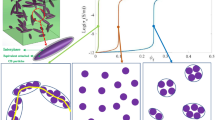Abstract
Samples of a polymer composite based on polypropylene and vanadium dioxide VO2 with the volume concentration from 0 to 1 were investigated. It was shown that the electrical conductivity of composites has the percolation-like character, and the current–voltage characteristics are S-shaped. In the temperature dependence of the electrical resistance of the composites samples, a sharp resistance decrease was detected at the temperature of the semiconductor–metal phase transition in VO2, sufficient for use in critical thermistor elements. It was established that the variance of the dielectric permittivity in the range of frequencies 105−107 Hz can be interpreted as part of the Maxwell’s mechanism of migration polarization associated with the separation of free charge carriers in vanadium dioxide particles in the semiconducting state. It was shown that the dependence of the low-frequency dielectric permittivity on the volume concentration of the filler can be interpreted in terms of a statistical mixture model.







Similar content being viewed by others
References
Y. Cui, X. Wang, Y. Zhoua et al., Synthesis of vanadium dioxide thin films on conducting oxides and metal–insulator transition characteristics. J. Crystal Growth 338, 96–102 (2012). doi:10.1016/j.jcrysgro.2011.10.025
H. Kizuka, T. Yagi, J. Jia et al., Temperature dependence of thermal conductivity of VO2 thin films across metal–insulator transition. Jap. J. Appl. Phys. 54(5), 053201 (2015). doi:10.7567/JJAP.54.053201
W. Bruckner, H. Opperman, W. Reihelt, J.I. Terukow, F.A. Tschudnowski, E. Wolf, Vanadiumoxide: Darstellung, Eigenschaften, Anwendung. (Akademie-Verlag, Berlin, 1983)
A.I. Ivon, V.R. Kolbunov, I.M. Chernenko, Stability of electrical properties of vanadium dioxide based ceramics. J. Eur. Ceram. Soc. 19, 1883–1888 (1999)
J.M. Atkin, S. Berweger, E.K. Chavez, M.B. Raschke, Strain and temperature dependence of the insulating phases of VO2 near the metal-insulator transition. Phys. Rev. B 85, 020101(R) (2012). doi:10.1103/PhysRevB.85.020101
С Alfred-Duplan, J. Musso, J.-R. Gavarri, C. Cesari, Variable electrical properties in composites: application to vanadium dioxide pigments in a polyethylene host. J. Sol. State Chem. 10(1), 6–14 (1994). doi:10.1006/jssc.1994.1127
M.K. Kerimov, M.A. Kurbanov, I.S. Sultanahmedova et al., Varistor effect in polymer-semiconductor composites. Semiconductors 44(7), 934–942 (2010). doi:10.1134/S1063782610070134
V.V. Turov, P.P. Gorbik, V.M. Ogenko et al., Influence of tetraethylammonium bromide on phase inhomogeneity of disperse vanadium dioxide particles in matrix of polyethylene glycol. App. Surf. Sci. 166, 492–496 (2000). doi:10.1016/S0169-4332(00)00481-5
Y.P. Mamunya, V.V. Davydenko, P. Pissis, E.V. Lebedev, Electrical and thermal conductivity of polymers filled with metal powders. Eur. Polymer. J. 38(9), 1887–1897 (2002). doi:10.1016/S0014-3057(02)00064-2
J. Aneli, G. Zaikov, O Mukbaniani, Electric conductivity of polymer composites at mechanical relaxation. Chem. Chem. Technol. 5(2), 187–190 (2011)
Y.Q. Tan, L.J. Fang, J.L. Xiao et al., Grafting of copolymers onto graphene by miniemulsion polymerization for conductive polymer composites: improved electrical conductivity and compatibility induced by interfacial distribution of grapheme. Polymer. Chem. 4(10), 2939–2944 (2013). doi:10.1039/C3PY00164D
H. Pang, L. Xu, D.X. Yan, Z.M. Li, Conductive polymer composites with segregated structures. Progress Polymer. Sci. 3(11), 1908–1933 (2014). doi:10.1016/j.progpolymsci.2014.07.007
H.R. Seung, K. Seil, K. Han et al., Highly conductive polymer composites incorporated with electrochemically exfoliated graphene fillers. RSC Adv. 46(5), 36456–36460 (2015). doi:10.1039/C5RA04202J
A.M. Hashimov, S.M. Hasanli, R.N. Mehdizadeh et al., Nonlinear resistor based on a polymer-ceramic composition. Tech. Phys. 52(8), 1086–1088 (2007). doi:10.1134/S1063784207080208
AY Lyashkov, AS Tonkoshkur, Varistor composites with a positive temperature coefficient of resistance. Tech. Phys. 56(3), 427–428 (2011). doi:10.1134/S1063784211030121
K.V. Antonova, V.R. Kolbunov, A.S. Tonkoshkur, Structure and properties of polymer composites based on vanadium dioxide. J. Polymer Res. 21(5), 1–5 (2014). doi:10.1007/s10965-014-0422-7
A.I. Ivon, I.M. Chernenko, V.R. Kolbunov, Process for preparing of vanadium dioxide. Ukraine Patent 40041 A (UA) №99010384, 16 July 2001
I.М. Afanasov, V.А. Morozov, A.V. Kepman et al., Preparation, electrical and thermal properties of new exfoliated graphite-based composites. Carbon 47(1), 263–270 (2009). doi:10.1016/j.carbon.2008.10.004
C. Garzón, H. Palza, Electrical behavior of polypropylene composites melt mixed with carbon-based particles: Effect of the kind of particle and annealing process. Compos. Sci. Tech. 99, 117–123 (2014). doi:10.1016/j.compscitech.2014.05.018
J. Frohlich, W. Niedermeier, H.D. Luginsland, The effect of filler–filler and filler–elastomer interaction on rubber reinforcement. Compos. Part A Appl. Sci. Manuf. 36(4), 449–460 (2005). doi:10.1016/j.compositesa.2004.10.004
A. Montazeri, R. Naghdabadi, Investigation of the interphase effects on the mechanical behavior of carbon nanotube polymer composites by multiscale modeling. J. Appl. Polymer Sci. 117(1), 361–367 (2010). doi:10.1002/app.31460
S. Kirkpatrick, Percolation and conduction. Rev. Mod. Phys. 45, 574–588 (1973). doi:10.1103/RevModPhys.45.574
B.I. Shklovskii, A.L. Efros, Electronic Properties of Doped Semiconductors. (Springer-Verlag, Berlin, 1983)
B. Brunson, Hopping conductivity and charge transport in low density polyethylene. Utah State University: all Graduate Theses and Dissertations. Paper 562, 2010
A.S. Tonkoshkur, A.Y. Lyashkov, A.V. Degtyaryov, Size effects in electrical properties of carbon-polypropylene composites. Ukr. J. Phys. 61(11), 1108–1016 (2016)
C.N. Berglund, H.J. Guggenheim, Electronic properties of VO2 near the semiconductor-metal transition. Phys. Rev. 185(3), 1022–1033 (1969). doi:10.1103/PhysRev.185.1022
V.R. Kolbunov, A.I. Ivon, I.M. Chernenko, Conductivity of VO2-based ceramics. J. Mater. Sci. 17, 57–62 (2006). doi:10.1007/s10854-005-5142-7
S.S. Dukhin, V.N. Shilov, Dielectric Phenomena and the Double Layer in Disperse Systems and Polyelectrolytes, (Übersetzt aus dem Russischen von D. Ledermann; Herausgeber: P. Greenberg), J. (Wiley and Sons, New York, 1974)
G. Bànhegyi, Numerical analysis of complex dielectric mixture formulae. Colloid Polymer Sci. 266(1), 11–28 (1988). doi:10.1007/BF01451527
E.P. Moore, Polypropylene Handbook. Polymerization, Characterization, Properties, Processing, Applications. (Hanser Publishers, New York, 1996)
S.-G. Shin, I.-K. Kwo, Effect of temperature on the dielectric properties of carbon black-filled polyethylene matrix composites below the percolation threshold. Electron. Mater. Lett. 7(3), 249–254 (2011). doi:10.1007/s13391-011-0913-1
I.A. Morozov, A.L. Svistkov, G. Heinrich, B. Lauke, Structure of the carbon-black-particles framework in filled elastomer materials. Polymer Sci. Series A. 49(3), 292–299 (2007). doi:10.1134/S0965545X07030091
A.V. Degtyar’ov, A.S. Tonkoshkur, Electric conductivity of PTCR polyethylene-graphite composites. Ukr. J. Phys. 52(9), 863–867 (2007)
Author information
Authors and Affiliations
Corresponding author
Ethics declarations
Conflict of interest
The authors declare that they have no conflict of interest.
Rights and permissions
About this article
Cite this article
Kolbunov, V.R., Tonkoshkur, A.S. & Gomilko, I.V. Electrical and dielectric properties of polymer composite based on vanadium dioxide. J Mater Sci: Mater Electron 28, 8322–8328 (2017). https://doi.org/10.1007/s10854-017-6547-9
Received:
Accepted:
Published:
Issue Date:
DOI: https://doi.org/10.1007/s10854-017-6547-9




